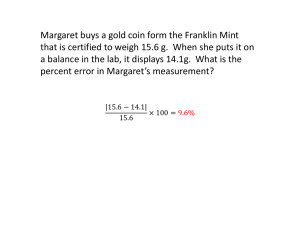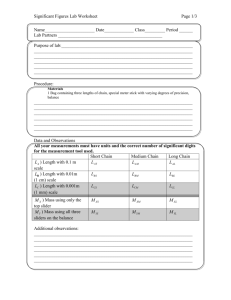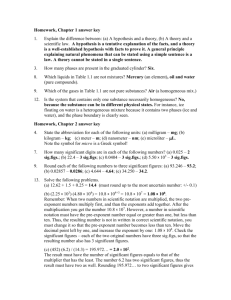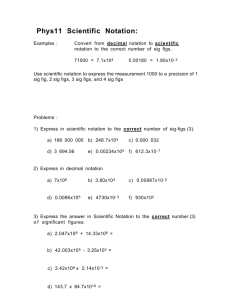Dr. Phil`s Handy Guide to Easy Scientific Notation and Significant
advertisement
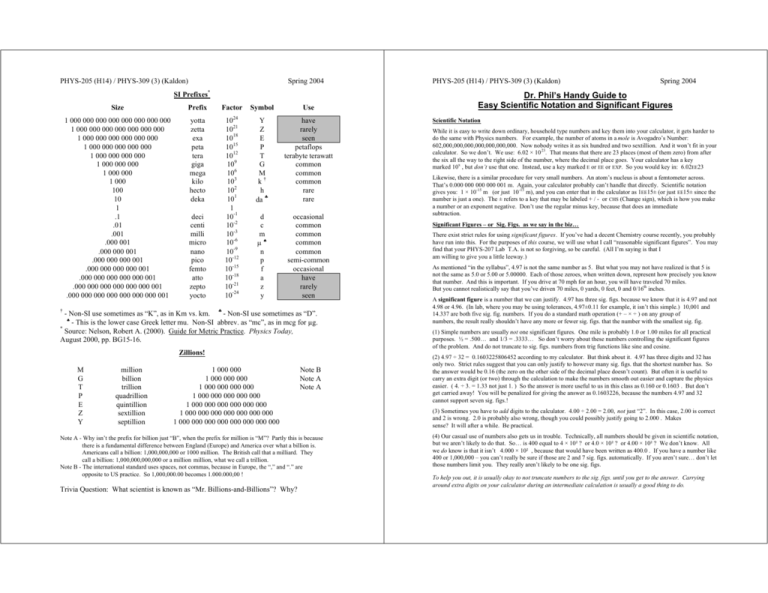
PHYS-205 (H14) / PHYS-309 (3) (Kaldon) Spring 2004 * SI Prefixes Size Prefix Factor Symbol Use 1 000 000 000 000 000 000 000 000 1 000 000 000 000 000 000 000 1 000 000 000 000 000 000 1 000 000 000 000 000 1 000 000 000 000 1 000 000 000 1 000 000 1 000 100 10 1 .1 .01 .001 .000 001 .000 000 001 .000 000 000 001 .000 000 000 000 001 .000 000 000 000 000 001 .000 000 000 000 000 000 001 .000 000 000 000 000 000 000 001 yotta zetta exa peta tera giga mega kilo hecto deka 1024 1021 1018 1015 1012 109 106 103 102 101 1 10-1 10-2 10-3 10-6 10-9 10-12 10-15 10-18 10-21 10-24 Y Z E P T G M k† h da § have rarely seen petaflops terabyte terawatt common common common rare rare d c m mª n p f a z y occasional common common common common semi-common occasional have rarely seen deci centi milli micro nano pico femto atto zepto yocto § † - Non-SI use sometimes as “K”, as in Km vs. km. - Non-SI use sometimes as “D”. ª - This is the lower case Greek letter mu. Non-SI abbrev. as “mc”, as in mcg for µg. * Source: Nelson, Robert A. (2000). Guide for Metric Practice. Physics Today, August 2000, pp. BG15-16. Zillions! M G T P E Z Y million billion trillion quadrillion quintillion sextillion septillion 1 000 000 1 000 000 000 1 000 000 000 000 1 000 000 000 000 000 1 000 000 000 000 000 000 1 000 000 000 000 000 000 000 1 000 000 000 000 000 000 000 000 Note B Note A Note A Note A - Why isn’t the prefix for billion just “B”, when the prefix for million is “M”? Partly this is because there is a fundamental difference between England (Europe) and America over what a billion is. Americans call a billion: 1,000,000,000 or 1000 million. The British call that a milliard. They call a billion: 1,000,000,000,000 or a million million, what we call a trillion. Note B - The international standard uses spaces, not commas, because in Europe, the “,” and “.” are opposite to US practice. So 1,000,000.00 becomes 1.000.000,00 ! Trivia Question: What scientist is known as “Mr. Billions-and-Billions”? Why? PHYS-205 (H14) / PHYS-309 (3) (Kaldon) Spring 2004 Dr. Phil’s Handy Guide to Easy Scientific Notation and Significant Figures Scientific Notation While it is easy to write down ordinary, household type numbers and key them into your calculator, it gets harder to do the same with Physics numbers. For example, the number of atoms in a mole is Avogadro’s Number: 602,000,000,000,000,000,000,000. Now nobody writes it as six hundred and two sextillion. And it won’t fit in your calculator. So we don’t. We use: 6.02 × 10 23. That means that there are 23 places (most of them zero) from after the six all the way to the right side of the number, where the decimal place goes. Your calculator has a key marked 10x , but don’t use that one. Instead, use a key marked E or EE or EXP. So you would key in: 6.02EE23 Likewise, there is a similar procedure for very small numbers. An atom’s nucleus is about a femtometer across. That’s 0.000 000 000 000 001 m. Again, your calculator probably can’t handle that directly. Scientific notation gives you: 1 × 10-15 m (or just 10-15 m), and you can enter that in the calculator as 1EE15± (or just EE15± since the number is just a one). The ± refers to a key that may be labeled + / - or CHS (Change sign), which is how you make a number or an exponent negative. Don’t use the regular minus key, because that does an immediate subtraction. Significant Figures – or Sig. Figs. as we say in the biz… There exist strict rules for using significant figures. If you’ve had a decent Chemistry course recently, you probably have run into this. For the purposes of this course, we will use what I call “reasonable significant figures”. You may find that your PHYS-207 Lab T.A. is not so forgiving, so be careful. (All I’m saying is that I am willing to give you a little leeway.) As mentioned “in the syllabus”, 4.97 is not the same number as 5. But what you may not have realized is that 5 is not the same as 5.0 or 5.00 or 5.00000. Each of those zeroes, when written down, represent how precisely you know that number. And this is important. If you drive at 70 mph for an hour, you will have traveled 70 miles. But you cannot realistically say that you’ve driven 70 miles, 0 yards, 0 feet, 0 and 0/16th inches. A significant figure is a number that we can justify. 4.97 has three sig. figs. because we know that it is 4.97 and not 4.98 or 4.96. (In lab, where you may be using tolerances, 4.97±0.11 for example, it isn’t this simple.) 10,001 and 14.337 are both five sig. fig. numbers. If you do a standard math operation (+ – × ÷ ) on any group of numbers, the result really shouldn’t have any more or fewer sig. figs. that the number with the smallest sig. fig. (1) Simple numbers are usually not one significant figures. One mile is probably 1.0 or 1.00 miles for all practical purposes. ½ = .500… and 1/3 = .3333… So don’t worry about these numbers controlling the significant figures of the problem. And do not truncate to sig. figs. numbers from trig functions like sine and cosine. (2) 4.97 ÷ 32 = 0.1603225806452 according to my calculator. But think about it. 4.97 has three digits and 32 has only two. Strict rules suggest that you can only justify to however many sig. figs. that the shortest number has. So the answer would be 0.16 (the zero on the other side of the decimal place doesn’t count). But often it is useful to carry an extra digit (or two) through the calculation to make the numbers smooth out easier and capture the physics easier. ( 4. ÷ 3. = 1.33 not just 1. ) So the answer is more useful to us in this class as 0.160 or 0.1603 . But don’t get carried away! You will be penalized for giving the answer as 0.1603226, because the numbers 4.97 and 32 cannot support seven sig. figs.! (3) Sometimes you have to add digits to the calculator. 4.00 ÷ 2.00 = 2.00, not just “2”. In this case, 2.00 is correct and 2 is wrong. 2.0 is probably also wrong, though you could possibly justify going to 2.000 . Makes sense? It will after a while. Be practical. (4) Our casual use of numbers also gets us in trouble. Technically, all numbers should be given in scientific notation, but we aren’t likely to do that. So… is 400 equal to 4 × 10² ? or 4.0 × 10² ? or 4.00 × 10² ? We don’t know. All we do know is that it isn’t 4.000 × 10² , because that would have been written as 400.0 . If you have a number like 400 or 1,000,000 – you can’t really be sure if those are 2 and 7 sig. figs. automatically. If you aren’t sure… don’t let those numbers limit you. They really aren’t likely to be one sig. figs. To help you out, it is usually okay to not truncate numbers to the sig. figs. until you get to the answer. Carrying around extra digits on your calculator during an intermediate calculation is usually a good thing to do.




